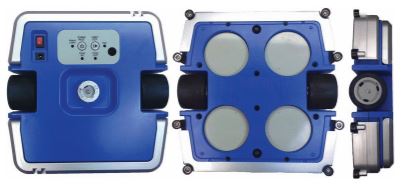WINDORO : The World’s First Commercialized Window Cleaning Robot for Domestic Use
This article presents the WINDORO, the first commercialized window cleaning robot in the world.
At first, the current autonomous window cleaning technologies are discussed. It is said that every window cleaning robot has three elements: an adhering unit, for which vacuum suckers are often used, a window cleaning unit and a driving unit, which is responsible for moving the robot over the glass. Most of the current driving units often use wheels for continuous movement or legged locomotion to create a discrete walking on the glass. After this, it is stated that these current kind of window cleaning are impractical and dangerous, so therefore the WINDORO is developed. It is much more practical. It has namely a small, slim, light, safe and energy efficient system and does not need cables or pipelines. This makes the WINDORO better than other designs.
Subsequently, the mechanical design of the WINDORO is discussed. This window cleaning robot adheres to the glass by means of 2 magnet units on each side on the glass. The inner unit (see figure) is responsible for navigation and works via two silicon driving wheels which have a high coefficient of friction. The inner unit also has a magnetic force control mechanism. The vertical position of the magnet holder can be manually adjusted by rotating the screw on the surface. This is very important for coping with different glass thicknesses. The outer unit is responsible for cleaning and works via four motorized rotating disks with a pad for cleaning. Cleaning pads can be easily removed or replaced because they are connected to the rotating disks with velcro. The outer unit also consists of a water tank filled with liquid detergent. A nozzle sprays the volume of this tank on the glass surface by using a small water pump.
Furthermore the control system of the WINDORO is discussed. The inner unit is the master controller and communicates the user input to the outer unit, the slave controller. The outer controller sends in turn information about its operation (e.g. battery levels) via a wireless connection to the inner unit. The inner unit has also a sensor to measure the movement of the WINDORO and uses its feedback to control the moving direction.
The algorithm of the cleaning method is also presented. First the WINDORO estimates the dimensions of the window by making smart movements. Second, it repeats a zigzag motion to completely clean the glass. During this zigzag motion the vertical slippage is reduced by means of a control loop. The vertical slippage is not always perfectly predictable, because it strongly depends on the condition of the glass. Therefore a button is added to modify the moving direction manually. After cleaning or when the battery levels are low, the windoro has the ability to go back to its start position and can be easily removed from the window by the user.
Experiments were performed and demonstrated the system’s reliability, mobility and stability. A vertical glass wall was observed with a camera, to map the movements of the WINDORO. There was an window cleaning task performed with and without the silicon tires of the inner unit. It turned out that the distance between the sweeping lines of the robot without the silicon tires tended to increase more than with the silicon tires, which means that in the case of not using silicon tires, the glass could not be completely cleaned. The WINDORO was also tested in real life environments (e.g. windows with stickers, very dirty windows), which also confirmed the reliability of the robot. Eventually suggestions for future work are posed. There is room for improvement in keeping the gap between the horizontal sweeping lines constant and in developing a magnetic force control that can work fully autonomous instead of manually turning a button.
